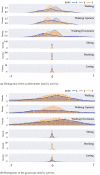LSTM Networks Using Smartphone Data for Sensor-Based Human Activity Recognition in Smart Homes
- PMID: 33652697
- PMCID: PMC7956629
- DOI: 10.3390/s21051636
LSTM Networks Using Smartphone Data for Sensor-Based Human Activity Recognition in Smart Homes
Abstract
Human Activity Recognition (HAR) employing inertial motion data has gained considerable momentum in recent years, both in research and industrial applications. From the abstract perspective, this has been driven by an acceleration in the building of intelligent and smart environments and systems that cover all aspects of human life including healthcare, sports, manufacturing, commerce, etc. Such environments and systems necessitate and subsume activity recognition, aimed at recognizing the actions, characteristics, and goals of one or more individuals from a temporal series of observations streamed from one or more sensors. Due to the reliance of conventional Machine Learning (ML) techniques on handcrafted features in the extraction process, current research suggests that deep-learning approaches are more applicable to automated feature extraction from raw sensor data. In this work, the generic HAR framework for smartphone sensor data is proposed, based on Long Short-Term Memory (LSTM) networks for time-series domains. Four baseline LSTM networks are comparatively studied to analyze the impact of using different kinds of smartphone sensor data. In addition, a hybrid LSTM network called 4-layer CNN-LSTM is proposed to improve recognition performance. The HAR method is evaluated on a public smartphone-based dataset of UCI-HAR through various combinations of sample generation processes (OW and NOW) and validation protocols (10-fold and LOSO cross validation). Moreover, Bayesian optimization techniques are used in this study since they are advantageous for tuning the hyperparameters of each LSTM network. The experimental results indicate that the proposed 4-layer CNN-LSTM network performs well in activity recognition, enhancing the average accuracy by up to 2.24% compared to prior state-of-the-art approaches.
Keywords: HAR; LSTM; deep learning; feature extraction; smartphone sensor; time-series data.
Conflict of interest statement
The authors declare no conflict of interest.
Figures



















References
-
- Shih C.S., Chou J.J., Lin K.J. WuKong: Secure Run-Time environment and data-driven IoT applications for Smart Cities and Smart Buildings. J. Internet Serv. Inf. Secur. 2018;8:1–17.
-
- Jobanputra C., Bavishi J., Doshi N. Human Activity Recognition: A Survey. Procedia Comput. Sci. 2019;155:698–703. doi: 10.1016/j.procs.2019.08.100. - DOI
-
- Qi J., Yang P., Hanneghan M., Tang S., Zhou B. A Hybrid Hierarchical Framework for Gym Physical Activity Recognition and Measurement Using Wearable Sensors. IEEE Internet Things J. 2019;6:1384–1393. doi: 10.1109/JIOT.2018.2846359. - DOI
-
- Mekruksavanich S., Jitpattanakul A. Exercise Activity Recognition with Surface Electromyography Sensor using Machine Learning Approach; Proceedings of the 2020 Joint International Conference on Digital Arts, Media and Technology with ECTI Northern Section Conference on Electrical, Electronics, Computer and Telecommunications Engineering (ECTI DAMT and NCON); Pattaya, Thailand. 11–14 March 2020; pp. 75–78.
-
- Atapour C., Agrafiotis I., Creese S. Modeling Advanced Persistent Threats to enhance anomaly detection techniques. J. Wirel. Mob. Netw. Ubiquitous Comput. Dependable Appl. 2018;9:71–102.
MeSH terms
Grants and funding
LinkOut - more resources
Full Text Sources
Other Literature Sources
Miscellaneous

